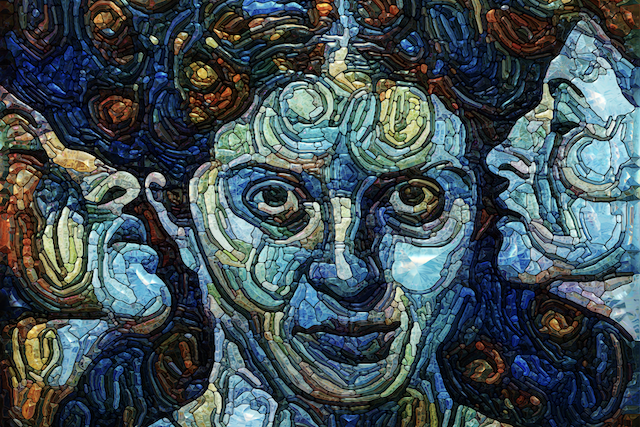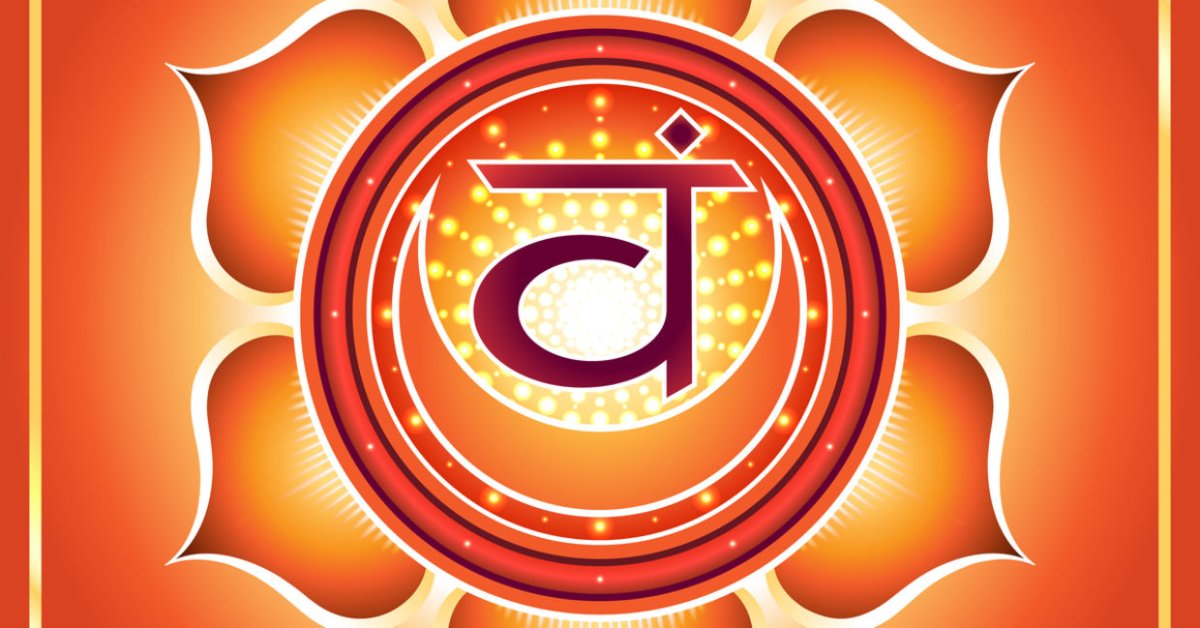The Four Generosities of the Buddha Ratnasambhava and the Jewel Family: Practices, Sutras, and Mantras to Conquer Pride with Equality
Why is Ratnasambhava Buddha described as the wish-granting Buddha? Why is he considered the Buddha closest to our world, always ready to help? What are the four generosities of the Jewel Buddha of the Earth? What is his great...

 Ratnasambhava Buddha is the head of the Ratna or Jewel family. He is golden in colour, to symbolize the earth element and his auspicious enriching power. He helps bring us the prosperity and auspicious circumstance that allow us to help sentient beings. To his left and right are his sacred animal, the horses who support his throne. They symbolize earth and wish-fuflilment.
Ratnasambhava Buddha is the head of the Ratna or Jewel family. He is golden in colour, to symbolize the earth element and his auspicious enriching power. He helps bring us the prosperity and auspicious circumstance that allow us to help sentient beings. To his left and right are his sacred animal, the horses who support his throne. They symbolize earth and wish-fuflilment.Why is Ratnasambhava Buddha described as the wish-granting Buddha? Why is he considered the Buddha closest to our world, always ready to help? What are the four generosities of the Jewel Buddha of the Earth? What is his great Dharani that delivers the four Generosities into our lives? We answer these questions, and more, in this in-depth presentation, and end with his Dharani, Mantras and Sadhana to help you connect directly to this generous and auspicious Buddha.
Ratnasambhava: Quick Snapshot
Buddha of the Southern Jewel Family Wisdom Mother: Mamaki (in some lineages Lochana) Bodhisattva: Ratnapani Wisdom of Equality Varada Mudra of Generosity Overcomes Poison of Jealousy Skanda or Aggregate: Feeling (the pleasant or unpleasant feelings we cling to or avoid) Pureland Shrimat Ratna means “Jewel” — the wish-granting jewel held in his left hand Members of Family include: Mochana, Wisdom King Gundari or Kundali (his wrathful Guardian King aspect), Yellow Jambhala, Vasudhara Yellow Tara, Ratnapani Element: Earth Symbol: Sacred Jewel (Ratna) Sacred Animals: Horse (and sometimes tiger) Seed Syllable: Tram Heart Mantra: Om Ratnasambhava Tram Color: Yellow or Gold, the flourishing warmth of living earth Season: Spring Ratnasambhava in his classic Buddha pose, as a Buddha in vajra posture, with his right hand in the gesture of generosity and his left in the mudra of meditate equipose holding the wish-granting jewel. He is the Buddha of the south, his element is the earth. He is called the wish-granting Buddha who brings auspiciousness. Most prosperity and auspiciousness practices are from his family, the Jewel or Padma family. Image will be available in our Gallery, created by Buddha Weekly, available for personal Dharma use. If you use the images publicly, please credit BuddhaWeekly.com. Thank you.
Ratnasambhava in his classic Buddha pose, as a Buddha in vajra posture, with his right hand in the gesture of generosity and his left in the mudra of meditate equipose holding the wish-granting jewel. He is the Buddha of the south, his element is the earth. He is called the wish-granting Buddha who brings auspiciousness. Most prosperity and auspiciousness practices are from his family, the Jewel or Padma family. Image will be available in our Gallery, created by Buddha Weekly, available for personal Dharma use. If you use the images publicly, please credit BuddhaWeekly.com. Thank you.
Auspicious Buddha of Equality
Ratnasambhava Buddha, the glorious and auspicious Buddha of the South is characterized by his open hand of generosity, the mudra of giving. Jetsun Dragpa Gyaltsen, one of the five Sakya patriarchs, who lived 1147 to 1216, described the glorious Buddha of Generosity this way:
Arising in the southern direction is Ratnasambhava on a horse, lotus and sun throne; with a body yellow in colour the right hand is placed in the mudra of supreme generosity.”
The mudra of generosity characterizes his vastly important wisdom. It is generosity and kindness and equality that defines the great Buddha closest to our earthly existence.
 Ratnasambhava with his sacred symbol the horse, the wish-granting jewel and the mudra of giving. Image will be available in our Gallery, created by Buddha Weekly, available for personal Dharma use. If you use the images publicly, please credit BuddhaWeekly.com. Thank you.
Ratnasambhava with his sacred symbol the horse, the wish-granting jewel and the mudra of giving. Image will be available in our Gallery, created by Buddha Weekly, available for personal Dharma use. If you use the images publicly, please credit BuddhaWeekly.com. Thank you.
He is the Buddha who grants wishes. As described by Konchog Ozer, from the Sadhana, which we recite at the end of this presentation:
He has “a radiant body having the colour of blazing gold, one face, two hands, the right is in supreme generosity — fulfilling the wishes of beings.”
 An artist interpretation of Ratnasambhava in his pujreland surrounded by followers. His hand is in the mudra of generosity and his left hand holds the wish-granting jewel. Image will be available in our Gallery, created by Buddha Weekly, available for personal Dharma use. If you use the images publicly, please credit BuddhaWeekly.com. Thank you.
An artist interpretation of Ratnasambhava in his pujreland surrounded by followers. His hand is in the mudra of generosity and his left hand holds the wish-granting jewel. Image will be available in our Gallery, created by Buddha Weekly, available for personal Dharma use. If you use the images publicly, please credit BuddhaWeekly.com. Thank you.
His wisdom is the wisdom of Equality, and his practice are the four generosities.
Ratnasambhava, and his family is characterized by the Dana Paramita, the Wisdom of Generosity, and especially by his Four Generosities: the generosity of helping sentient beings with material aid; the generosity of giving your karma or activity to create the causes for happiness of sentient beings; the generosity of fearlessness and protection to save and help others; and most importantly, the generosity of giving the Dharma teachings, which are the ultimate remedy to suffering.
The karma activity for accumulating wealth is generosity and giving, the activities of the Equality family of Ratnasambhava. There is an ancient saying, “If you want to be a rich person in your next life, give as much as you can in this life.”
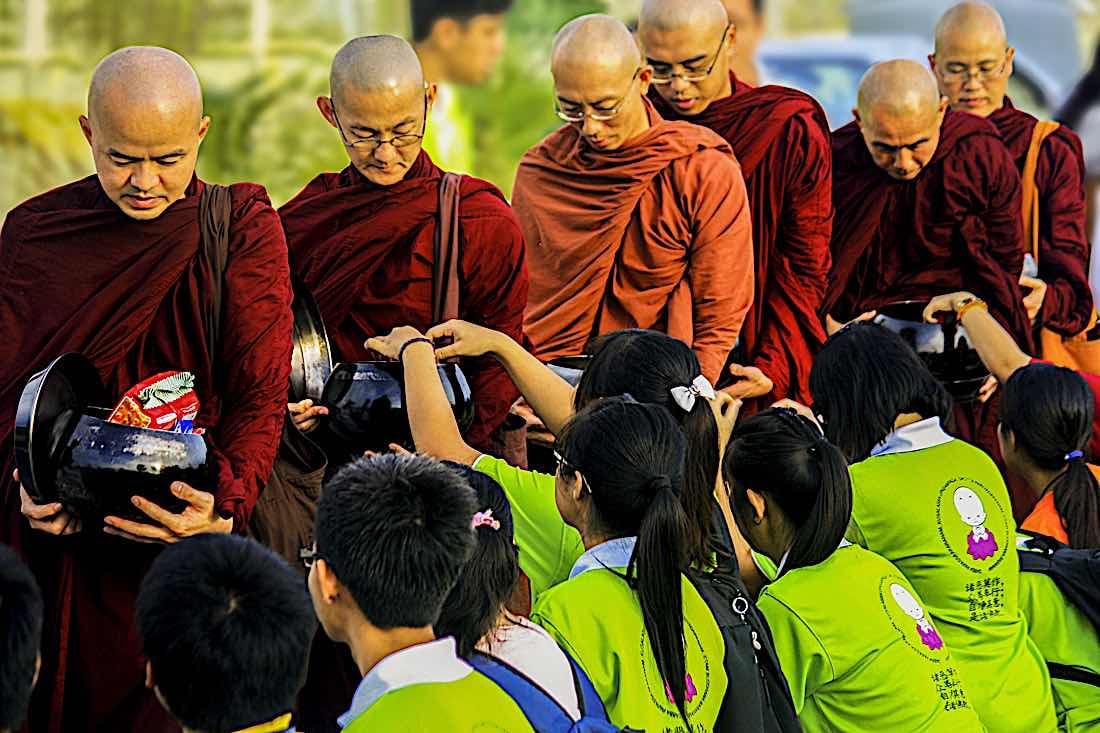 Youth give “dana” to monastic Sangha, a meritorious action. Generosity is one of the practices of Ratnasambhava.
Youth give “dana” to monastic Sangha, a meritorious action. Generosity is one of the practices of Ratnasambhava.
Practicing Ratnasambhava
Ratnasambhava’s practice is both demanding and simple. The practice is called making the Four Types of Gifts Daily. The other reinforcing practice is called the Sublime Attitudes, the brahmavihara, best known as the four immeasurables. These state, in different ways, the four generosities. The four Immeasurables are loving-kindness and benevolance or metta; compassion or karuna; empathetic joy or mudita, and equanimity or upekkha.
The all-important four generosities is reflected in the great Vajrayana vow called “the Commitment of the Great Supreme Jewel Family” that we take during empowerments. In this vow, there are five verses, one for each of the Dhyani Buddhas. The vow for Ratnasambhava expresses the practice of giving, generosity, and especially merit through offerings to the Three Jewels, the Buddha, Dharma and Sangha. It is, in fact, the entire practice of Ratnasmabhava. The Jewel Vow we repeat daily is:
I will always make the four types of gifts
Six times each day;
The pleasing commitments of
The great supreme Jewel family.
 Monk making daily offering of butter lamps at Drepung Monastery Lhasa Tibet.
Monk making daily offering of butter lamps at Drepung Monastery Lhasa Tibet.
The Four types of gifts are the Four Generosities of Ratnasambhava.
Each day, we are asked to give something material for the benefit of another sentient being, even if it’s just feeding a stray cat or the birds outside. This also includes offerings made on our altar to Buddha, Dharma and Sangha, such as water bowls, incense fruit or other symbolic offerings.
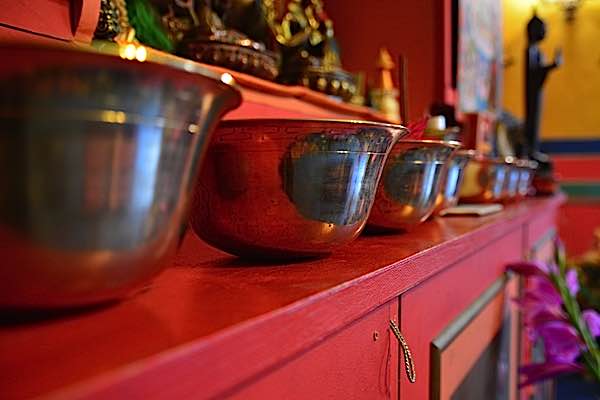 Water bowls are a virtuous offering placed in front of the Buddha. As you pour them, it is traditional to bless the water with Om Ah Hum or Om Svabhava Shuddhad Dharma Svabhava Shuddho Ham.
Water bowls are a virtuous offering placed in front of the Buddha. As you pour them, it is traditional to bless the water with Om Ah Hum or Om Svabhava Shuddhad Dharma Svabhava Shuddho Ham.
Each day we are also asked to perform generous acts, giving of our time, for the benefit of another sentient being — to create the causes for happiness for all beings, even if it’s just holding a door open for someone, or saying a kind word of support. Think about how you can help someone today.
Also, each day, we are asked to give fearless protection to help another being, even if it is only an insect or a small animal.
 Compassion and Loving Kindness are one of the four Generosities. Offering kind support to others is an offering to the Buddha, Dharma and Sangha.
Compassion and Loving Kindness are one of the four Generosities. Offering kind support to others is an offering to the Buddha, Dharma and Sangha.
And finally, each day, we are asked to give the gift of Dharma in some way. There are many ways to accomplish the gift of Dharma. Through writing sutras, chanting mantras, practicing your pujas, or just being supportive of the Dharma. Or, volunteering at a Dharma center. Or, sharing a Dharma video online. Anything that “Spreads the Dharma” is the final — and greatest — of the four Givings.
These four are the vow we give to Ratnasambhava during our Vajrayana Vow.
Six times a day in the vow, refers to making offerings six times a day, also called Six Session Yoga.
 Taking Refuge in the three Jewels Buddha, Dharma and Sangha over and over is important. By tradition we should do this at leas six times per day. You can simply hold your hands in front of you, and say “I take Refuge in the Three Jewels: Buddha, Dharma and Sangha, for the benefit of all sentient beings.”
Taking Refuge in the three Jewels Buddha, Dharma and Sangha over and over is important. By tradition we should do this at leas six times per day. You can simply hold your hands in front of you, and say “I take Refuge in the Three Jewels: Buddha, Dharma and Sangha, for the benefit of all sentient beings.”
To do this, six times a day, we try to take Refuge in the Three Jewels and make an offering. This can be an offering of a silently expressed mantra. Or a gift of food to someone who is hungry. Or any other gift that expresses generosity and Bodhichitta Intention.
Golden Yellow Jewel Family
Reinforcing his benevolent mission, Rantasambhava appears closest to Shakyamuni in appearance, reflecting he is of the earth.
 Ratnasambhava is the Buddha of the Earth element. Of the five Buddhas, he is the closest to us. His practices, and those of his family — Yellow Jambhala, Yellow Tara Vasudhara, Ratnapani are the practices of generosity and prosperity for the benefit of all sentient beings. As one of the most “active” in our world, the symbol of the horse is most appropriate. In his left hand is the wish-granting jewel or Dharma jewel. Image will be available in our Gallery, created by Buddha Weekly, available for personal Dharma use. If you use the images publicly, please credit BuddhaWeekly.com. Thank you.
Ratnasambhava is the Buddha of the Earth element. Of the five Buddhas, he is the closest to us. His practices, and those of his family — Yellow Jambhala, Yellow Tara Vasudhara, Ratnapani are the practices of generosity and prosperity for the benefit of all sentient beings. As one of the most “active” in our world, the symbol of the horse is most appropriate. In his left hand is the wish-granting jewel or Dharma jewel. Image will be available in our Gallery, created by Buddha Weekly, available for personal Dharma use. If you use the images publicly, please credit BuddhaWeekly.com. Thank you.
Ratnasambhava is golden and of the earth element. He is the Dhayani Wisdom Buddha closest to us — the Buddha ready to leap to our aid with material help, activity, protection, or teachings. He whispers in our ear and thoughts. He is present in our lives. He is always with us. His Jewelled paradise, Shrimat, his Pureland, is so close to our world, we just have to open our hearts to see it there.
Name in Other Languages
| रत्नसम्भव Ratnasambhava |
| (Traditional) 寶生如來 (Simplified) 宝生如来 (Pinyin: Bǎoshēng Rúlái) |
| 宝生如来ほうしょうにょらい (romaji: Hōshō Nyorai) |
| រតនសម្ភវៈ (ra-ta-na-som-pha-veak) |
| 보생여래 (RR: Bosaeng Yeorae) |
| ᠡᠷᠳᠡᠨᠢ ᠭᠠᠷᠬᠣ ᠢᠢᠨ ᠣᠷᠣᠨ Эрдэнэ гарахын орон Erdeni garkhu yin oron |
| རིན་ཆེན་འབྱུང་གནས་ or རིན་ཆེན་འབྱུང་ལྡན་ Wylie: rin chen ‘byung gnas THL: rin chen ‘byung ldan |
| Bảo Sanh Như Lai |
The Jewel Family: Wisdom of Equality Overcoming the Poison of Pride
The Jewel or Ratna Family is one of the Five Buddha Families in Vajrayana Buddhism, each symbolizing different wisdoms. At various times in our lives way may need different wisdoms. As Jealousy arises, we might turn to Amoghasiddhi and Tara for help. As anger arises, we might need the steadying wisdom of Akshobhya and Lochana with the Wisdom of Reflection.
The most common poison that afflicts us in Samsara is usually pride, which can give rise to the other poisons such as attachment, anger or jealousy. For Pride, we turn to the Ratna Family with their teachings on the five generosities and on the Wisdom of Equanimity or Equality.
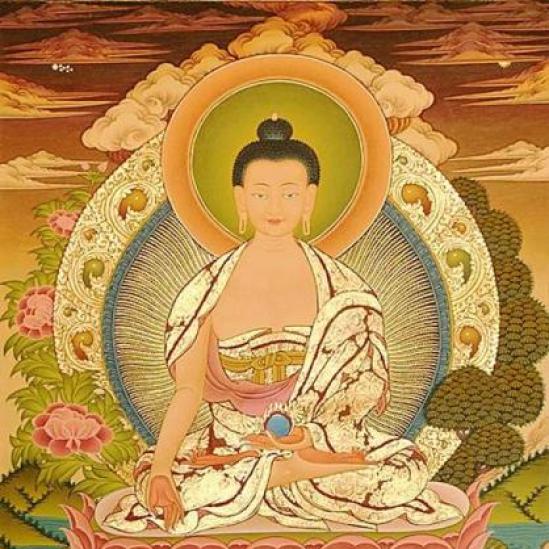 Ratnasambhava Buddha can be considered an emanation of Shakyamuni Buddha. He is visualized with a jewel, and like Shakyamuni, touches the earth as witness. His practice transforms the poison of Pride with the practice of Wisdom of Equality.
Ratnasambhava Buddha can be considered an emanation of Shakyamuni Buddha. He is visualized with a jewel, and like Shakyamuni, touches the earth as witness. His practice transforms the poison of Pride with the practice of Wisdom of Equality.
At the heart of this family is Ratnasambhava, the Buddha of the South, whose teachings focus on this Wisdom of Equality. This is, perhaps, the wisdom that today’s world most needs. With equality and equanimity arises compassion, kindness, support and love.
Ratnasambhava’s wisdom helps us transform the poison of pride into equanimity, allowing us to see and appreciate the intrinsic value and equality of all beings. With that great Mahayana view, our generosity and kindness grows, like a wholesome infection. Kindness, just like it’s opposite hate, tends to flourish.
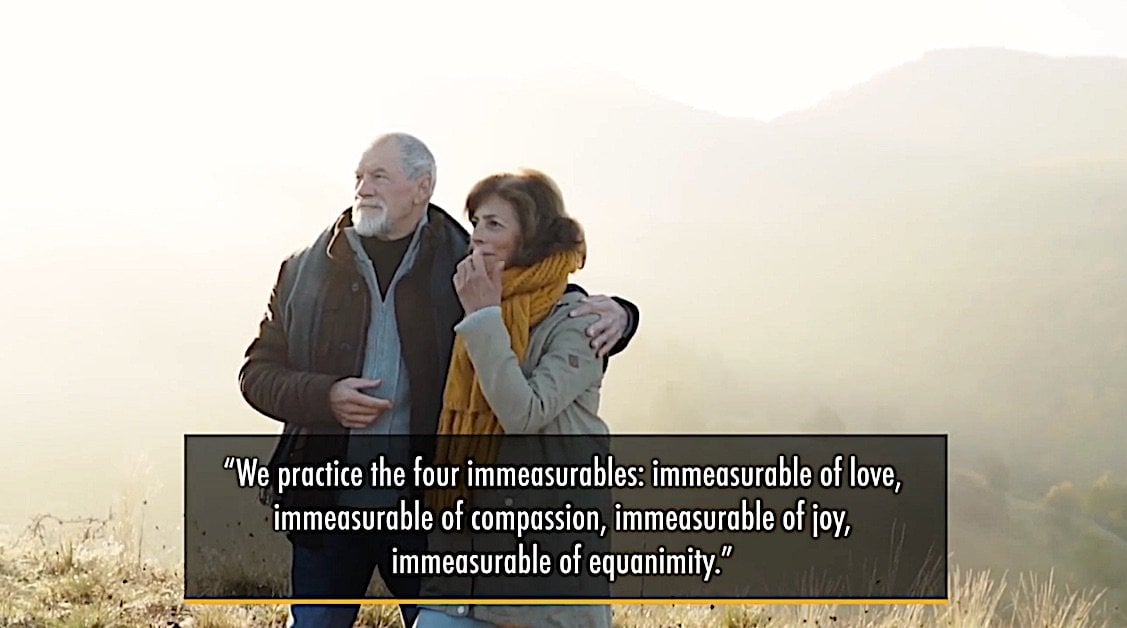 The four immeasurables are love, compassion, joy and equanimity. These are the four immeasurables, which reflect the gifts of Ratnasambhava’s four generosities.
The four immeasurables are love, compassion, joy and equanimity. These are the four immeasurables, which reflect the gifts of Ratnasambhava’s four generosities.Pride, from a Buddhist perspective, is considered a significant obstacle on the path to enlightenment. Ratnasambhava and the Jewel Family focus all practices on the remedy to Pride, which is called the Four Generosities.
Mamaki, Ratnasambhava’s sacred Wisdom Partner balances Ratnasambhava’s compassion with Wisdom. Together, they represent the perfect fusion of wisdom and compassion.
 Ratnasambhava with his sacred animal, the horse, representing his dynamic energy on the earth, and his wish-granting jewel in his left hand. Image will be available in our Gallery, created by Buddha Weekly, available for personal Dharma use. If you use the images publicly, please credit BuddhaWeekly.com. Thank you.
Ratnasambhava with his sacred animal, the horse, representing his dynamic energy on the earth, and his wish-granting jewel in his left hand. Image will be available in our Gallery, created by Buddha Weekly, available for personal Dharma use. If you use the images publicly, please credit BuddhaWeekly.com. Thank you.
Wish-Granting Jewel
The symbol of the Ratna Family is the wish-granting jewel, representing the preciousness of enlightenment and the inherent value within every sentient being. This powerful symbol serves as a reminder of the boundless potential within us and the importance of recognizing this in every interaction. By internalizing the teachings of Ratnasambhava and his consort, we not only combat pride but also cultivate a deep, abiding sense of equality and connection with the world around us.
Engaging with the practices and sadhanas associated with the Jewel Family invites us to reflect deeply on our own tendencies toward pride — while transforming the poison into the wisdom of equality. One of the merits of the practice is to bring auspiciousness, bounty, good fortune, and resources, so that we may help as many beings as possible.
 The full prostration is sometimes difficult to accept for western Buddhists. It is a sign of respect for Buddha, Dharma, Sangha and Guru, and also a remedy for pride.
The full prostration is sometimes difficult to accept for western Buddhists. It is a sign of respect for Buddha, Dharma, Sangha and Guru, and also a remedy for pride.
The Essence of Ratnasambhava: Embodying the Wisdom of Equality
As you delve deeper into understanding Ratnasambhava, you encounter a profound teaching on the Wisdom of Equality. This wisdom is not merely an abstract concept but a transformative practice that dissolves the divisions created by pride. Imagine a world where all beings are seen through a lens of equal potential and intrinsic worth—this is the essence of Ratnasambhava’s wisdom.
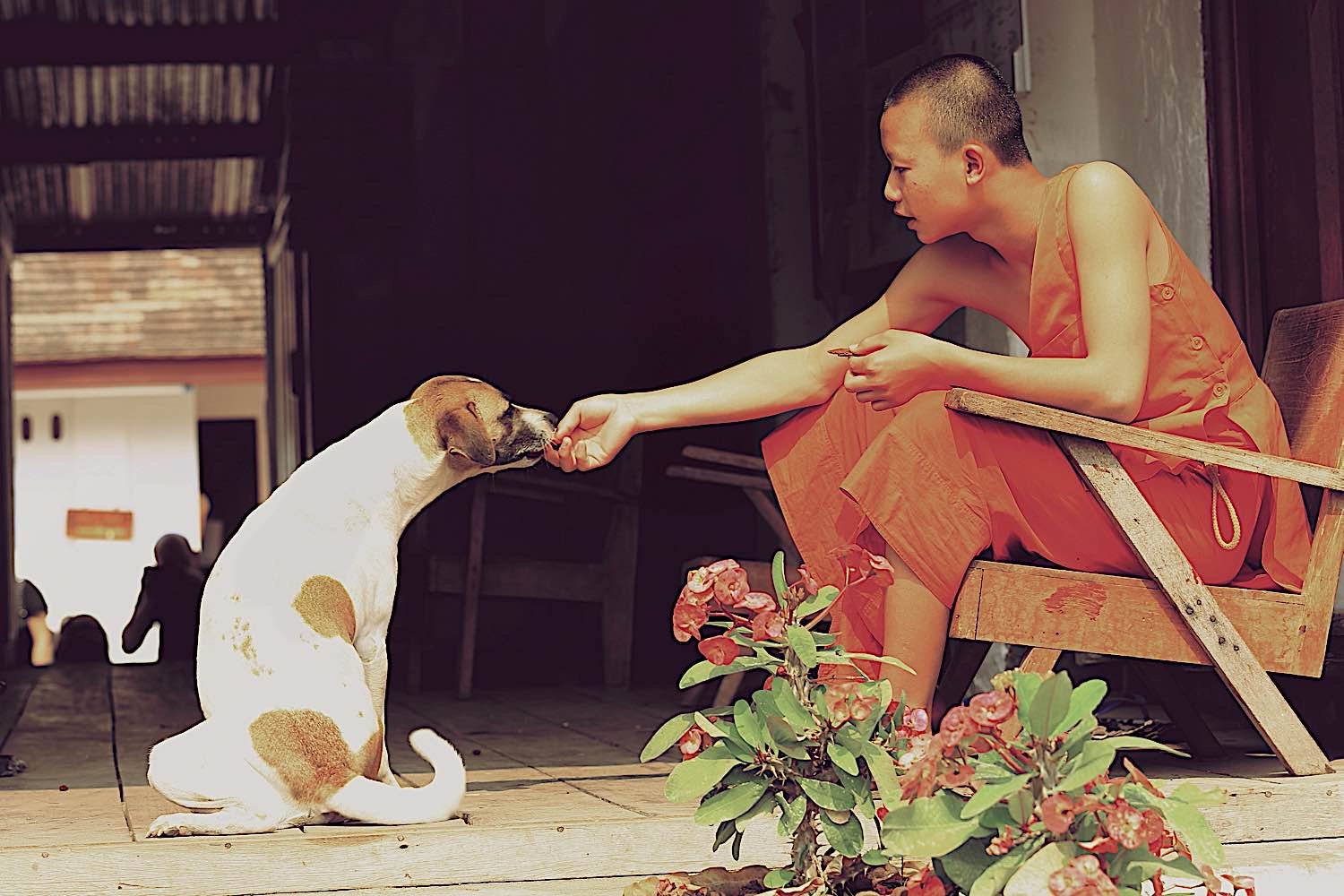 All acts of generosity are “prescribed” as the cure for the poison of pride and greed, among other solutions. Even feeding a stray dog, or the birds, or any act of generosity is an activity that helps us overcome pride and helps us practice one of the four generosities, practices of Ratnasambhava.
All acts of generosity are “prescribed” as the cure for the poison of pride and greed, among other solutions. Even feeding a stray dog, or the birds, or any act of generosity is an activity that helps us overcome pride and helps us practice one of the four generosities, practices of Ratnasambhava.
One of the most remarkable aspects of Ratnasambhava’s teachings is how they invite you to embrace equanimity. Equanimity is the ability to remain balanced and centered in the face of life’s constant flux. By embodying this quality, you cultivate a mind that views success and failure, praise and blame, pleasure and pain with an even gaze. It’s about finding that middle ground where you neither exalt nor diminish yourself or others.
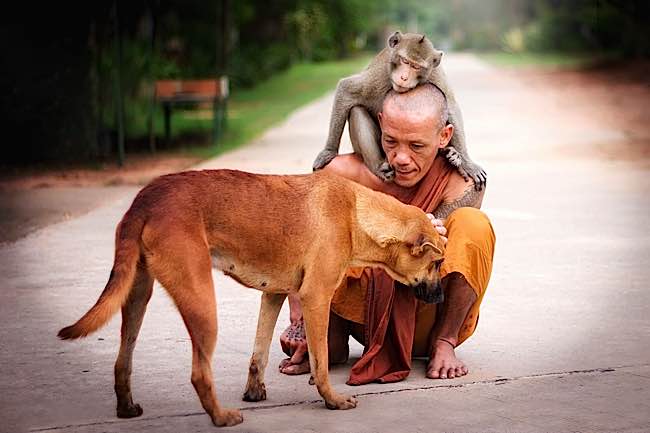 A Buddhist monk shares a tender moment with a dog and monkey. Every small act of compassion, support, love, metta and karuna are acts of generosity, which are the practices of Ratnasambhava.
A Buddhist monk shares a tender moment with a dog and monkey. Every small act of compassion, support, love, metta and karuna are acts of generosity, which are the practices of Ratnasambhava.
Compassion and Oneness
The Wisdom of Equality is intrinsically linked to compassion and unity. When you practice seeing everyone as equals, you naturally develop a deeper sense of compassion. You recognize that every being, regardless of their status or achievements, shares the same inherent value. This recognition fosters a solidarity that transcends superficial differences, leading to genuine unity and harmony.
 Generosity is always the first of the Six Paramitas: Generosity, Discipline, Patience, Diligence, Meditative Concentration and Wisdom.
Generosity is always the first of the Six Paramitas: Generosity, Discipline, Patience, Diligence, Meditative Concentration and Wisdom.
Another critical element of Ratnasambhava’s teachings is generosity. Embracing equality naturally leads to a generous heart, open to giving without a sense of superiority or attachment. Generosity here is not limited to material wealth but extends to time, attention, and emotional support. By sharing from a place of abundance, you reinforce the understanding that there is more than enough for everyone, fostering a sense of shared abundance.
Ratnasmbhava’s Serene Appearance
When you contemplate Ratnasambhava, visualize his serene and peaceful iconography. He is seated as Buddha in full vajra posture, with his right hand turned out in front of his knee in the gesture of giving or generosity. His left hand is on his lap in the gesture of meditative equipose, holding an upright wish-granting jewel, symbolizing his ability to grant the deepest spiritual and material needs of all beings. His image serves as a reminder of the inner wealth and benevolence that you can cultivate through the Wisdom of Equality.
 Ratnasambhava’s appearance is normally serene, with one hand held open to us in a gesture of generosity and the other holding a wish-granting jewel. Image will be available in our Gallery, created by Buddha Weekly, available for personal Dharma use. If you use the images publicly, please credit BuddhaWeekly.com. Thank you.
Ratnasambhava’s appearance is normally serene, with one hand held open to us in a gesture of generosity and the other holding a wish-granting jewel. Image will be available in our Gallery, created by Buddha Weekly, available for personal Dharma use. If you use the images publicly, please credit BuddhaWeekly.com. Thank you.
In essence, Ratnasambhava’s teachings offer a pathway to dissolve pride and cultivate a more compassionate and balanced perspective. Embrace these practices, and you will begin to see the world with the divine impartiality that Ratnasambhava embodies.
Key Sutras That Illuminate the Path to Equality
The Buddha’s teachings are vast, yet several key sutras prominently highlight the essence of Ratnasambhava’s Wisdom of Equality. Delving into these sutras not only expands your understanding but also deepens your spiritual practice.
 Golden Light Sutra.
Golden Light Sutra.
The Golden Light Sutra or Suvarṇaprabhāsa Sūtra (Sanskrit: सुवर्णप्रभासोत्तमसूत्रेन्द्रराजः) contains the story of Ratnasambhava Buddha alongside the stories of the Four Guardian Kings. The Sutra of Golden Light offers a treasure trove of insights into equality and compassion. Dedicated to promoting universal peace and harmony, this scriptural text underscores the principles of respect for all life forms, aligning seamlessly with Ratnasambhava’s teachings.
The Śūraṅgama Sutra and Mantra, dedicates one entire division to Ratnasambhava as the Buddha of the Jewel Division in the South. This division holds a crucial responsibility, commanding vast demon armies from five directions. It is through this portrayal that Ratnasambhava showcases his power to transmute negativity and bring about positive transformation.
 The Surangama Sutra (Chinese translation from 1401 CE).
The Surangama Sutra (Chinese translation from 1401 CE).
The Ratna-gotra-vibhaga: This profound text focuses on the doctrine of Buddha Nature, and the Oneness of all beings, essential for comprehending the Jewel Family’s Equality Wisdom. It elucidates the inherent Buddha-nature within all beings, promoting the idea that everyone possesses the potential for enlightenment. By meditating on this sutra, you nurture an appreciation for the equality imbued in all life.
The Avatamsaka Sutra: Renowned for its rich and intricate teachings on the interdependence and unity of all phenomena, this sutra illuminates how every aspect of existence is intertwined. Ratnasambhava’s wisdom permeates this text, focusing on recognizing the value and equal worth of each being.
When practiced mindfully, the wisdom contained in these sutras acts as a powerful antidote to pride. They serve as guiding lights on your journey towards embodying the Wisdom of Equality, fostering a heart rich in compassion and a mind that views all beings impartially.
 Ratnasambhava Buddha. Image will be available in our Gallery, created by Buddha Weekly, available for personal Dharma use. If you use the images publicly, please credit BuddhaWeekly.com. Thank you.
Ratnasambhava Buddha. Image will be available in our Gallery, created by Buddha Weekly, available for personal Dharma use. If you use the images publicly, please credit BuddhaWeekly.com. Thank you.
Dharani and its Benefits
If there are sentient being, by upholding, making offering and reciting the name of this Tathagata Dharani, He will be reborn as a Chakravartin, the Great King of Dharma. Achieving the holy life and He will have great supernormal powers. Obtaining ten kinds of Dharani. The Tathagata and all the Buddhas like the sands of the Ganges River, they have spoken the truth. After numerous Kalpas, the one who upholds this dharani will not be undergoing reincarnation again. By continuously cultivating the seed of the path without losing the bodhicitta, He who upholds this dharani will be able to eternally destroy all the karmic offences and obtain the Sambhogakaya form of the Tathagata. Om Ratnasambhava Tram
南无宝生如来 虔诚供养宝生佛 是人不失菩提心 一句南无宝生如来 善根亦得现前 得天眼清静 天眼通 永离轮回 光明常自照曜 常作如来胜利之事
People who make sincere offerings to Ratnasambhava Buddha do not lose their bodhicitta. By reciting ‘Namo Ratnasambhava Buddha’ , good roots are also revealed. Gaining peace of mind, clear vision, and exit the loops of reincarnation forever. The light always shines upon the path thus to be able to always perform the Tathagata’s victorious deeds.
 Ratnasambhava Buddha. Image will be available in our Gallery, created by Buddha Weekly, available for personal Dharma use. If you use the images publicly, please credit BuddhaWeekly.com. Thank you.
Ratnasambhava Buddha. Image will be available in our Gallery, created by Buddha Weekly, available for personal Dharma use. If you use the images publicly, please credit BuddhaWeekly.com. Thank you.
Ratnasambhava Buddha Dharani
Namo Ratna Rasmi Chandra Pratimandita Vidyam Teja Kosesvara Rajaya Tathagataya Arhate Samyak-sambuddhaya. Tadyatha, Ratne Ratne, Ratna Kirane, Ratna Pratimandite, Ratna Sambhave, Ratna Prabhe, Ratnod-gate Svaha
णमो रत्न रस्मी चन्द्र प्रतिमन्दिता विद्यम टेज कोसेस्वरा रजय टथगतय अर्हते सम्यक्-सम्बुद्धय । टद्यथ, रत्ने रत्ने, रत्न किरने, रत्न प्रतिमन्दिते, रत्न सम्भवे, रत्न प्रभे, रत्नोद्-गते स्वहा
若有众生。于此如来陀罗尼名号受持供养。彼人生生得转轮位。成就梵行具大神通。获十种陀罗尼。复值恒河沙等诸佛如来而无虚妄。经俱胝劫不入轮回路。不断菩提种不失菩提心。永灭一切罪得报身如来。
Ratnasambhava Sadhana
(Frontal Generation description source: Konchog Ozer)
namo ratnasambhava buddhayah
namo buddhaya guruve
namo dharmaya tayine.
namo samghaya mahate.
tribhyopi satatam namaha.
Homage to Ratnasambhava Buddha.
Homage to the Buddha, the Teacher
Homage to the Dharma, the Protector
Homage to the Great Sangha
To all of these I continually offer homage.
While visualizing the merit field, I offer the Seven Limbs of Practice:
I go for refuge to Ratnasambhava, the Buddhas, the Dharma and the Highest Assembly.
I declare every nonvirtuous act since beginningless time.
I rejoice in all virtues of holy and ordinary beings.
I will cultivate the Bodhichitta, to most effectively benefit all sentient beings.
Having generated the intention to take the Buddha’s path, I will care for all sentient beings as my guests. I offer flowers, incense, light, fragrances, food, music and the like, both those actually arranged and those mentally imagined.
I offer the four types of gifts
Six times each day;
The pleasing commitments of
The great supreme Jewel family.
Supreme gathering, please accept them.
I will practice the four generosities, the generosity of helping sentient beings with material aid; the generosity of giving my activities to create the causes for happiness of sentient beings; the generosity of fearlessness and protection to save and help others; and the generosity of giving the Dharma teachings.
I will in this way cultivate the Bodhichitta.
I wish that all beings may have happiness and its causes.
May we never have suffering nor its causes.
May we constantly dwell in joy transcending sorrow.
May we dwell in equal love for both near and far.
Supreme merit field, please remain in Samsara and turn the Wheel of the Dharma of the greater and lesser vehicles, to benefit all sentient beings!
I now visualize the merit field.
Appearances and existence, all phenomena of samsara and nirvana are empty by nature. Realizing this, within that state of emptiness, I visualize a glowing, illuminated yellow Tram syllable, on a shining lotus throne.
Yellow golden light emanates from the Tram syllable, going out as an offering to all the Enlightened Beings. The light purifies the karma of all sentient beings in the universe, blessing them. The lights return and the Tram syllable and transforms into glorious Ratnasambhava, Golden Yellow in Color, seated on a lotus throne supported by great horses.
The essence of all qualities is Ratnasambhava. With a radiant body having the colour of shining gold, one face, two hands, the right is in supreme generosity — fulfilling the wishes of beings. Performing meditative stabilization, the left is in the mudra of meditation and holding a wish-granting jewel.
Seated in vajra posture, method and wisdom, and having the thirty-two marks of excellence. He is well adorned with jewels and beautiful silk garments. A million light rays of light goes out and returns, blessing all sentient beings. He has a voice possessing sixty separate tones and a mind continuum of immeasurable pristine awareness.
Holding this visualization, I recite the glorious Dharani:
Namo Ratna Rasmi Chandra Pratimandita Vidyam Teja Kosesvara Rajaya Tathagataya Arhate Samyak-sambuddhaya. Tadyatha, Ratne Ratne, Ratna Kirane, Ratna Pratimandite, Ratna Sambhave, Ratna Prabhe, Ratnod-gate Svaha
Namo Ratna Rasmi Chandra Pratimandita Vidyam Teja Kosesvara Rajaya Tathagataya Arhate Samyak-sambuddhaya. Tadyatha, Ratne Ratne, Ratna Kirane, Ratna Pratimandite, Ratna Sambhave, Ratna Prabhe, Ratnod-gate Svaha
Namo Ratna Rasmi Chandra Pratimandita Vidyam Teja Kosesvara Rajaya Tathagataya Arhate Samyak-sambuddhaya. Tadyatha, Ratne Ratne, Ratna Kirane, Ratna Pratimandite, Ratna Sambhave, Ratna Prabhe, Ratnod-gate Svaha
Om Ratnasambhava Tram
Om Ratnasambhava Tram
Om Ratnasambhava Tram
I dedicate the merit of this practice and offerings to the cause for Enlightenment for the benefit of all sentient beings.
[1]
NOTES:
[1] Ratnasambhava Buddha Dharani from Shurangama Dhamma Associationhttps://www.youtube.com/watch?v=UZEZyD4XBGw

 Troov
Troov 










